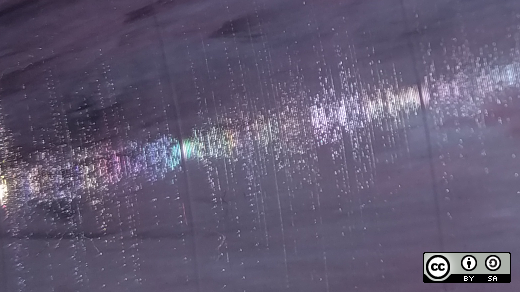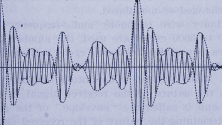This is my first article for a new column here on Opensource.com about music from an open point of view. Some things I won't be doing: I won't be concentrating solely on music released under an open license. I won't be writing (much) about making one's own music. I won't be writing (much) about music theory or professional matters, or probably really very much of anything of interest to professional musicians.
I will write about music I encounter that interests me for one reason or another. I'll tell you about how to enjoy music in an open environment, like on a Linux-based laptop, desktop, or server. I'll share hardware I've purchased or tried out that works well, and some that doesn't, in an open environment. I promise to write about good places to buy music that are Linux-friendly (that is, those that don't require installing downloaders that only run on other operating systems). And I will point out some other websites, and occasionally print media, that increases my enjoyment of music.
Besides that, who knows? I can think of two great science fiction novels in which music plays an important part. Maybe I'll write on that. Maybe I'll take an in-depth look at some open music playing software. Maybe I'll share some recipes (inherently open source, I've heard) that are particularly fun to cook or eat while blasting music in the kitchen. Who knows? When things are open, the sky is the limit!
And because this column is meant to be about music, one thing I will do without fail is recommend music.
The vinyl LP as open music
I dedicate this first article to my favorite open music format: the vinyl LP. For those of you who might not know, "LP" stands for Long Playing. Vinyl, according to a Wikipedia page that I highly recommend you read, refers to the chemical compound polyvinyl chloride, which is the main constituent of vinyl LPs.
One of the reasons I like the vinyl LP so much is because it is one of the few real working examples of steampunk technology. If I were to materialize onto an alternate Earth that had never invented the vinyl LP and I explained it to a physicist or engineer, I think it's safe to say that they'd be skeptical such a thing could work at all, and they would ridicule the idea that the material could reproduce music in a high fidelity fashion.
Why? Let's look at the various components in the reproduction chain for our answer. But first, how is the vinyl LP an open music format?
The vinyl LP was not always an open music format. The V-shaped groove mechanism was invented and patented by Alan Blumlein, who worked at EMI Group, in 1931. Today, that patent has long since expired. Similarly, the original designs for cartridges were patented in the early part of the 20th century. Nevertheless, busy inventors have continued to patent various improvements on the basic designs since then. Prior to Blumlein's work, there were other patent concerns tested in the courts. But these days it seems that the stereo vinyl LP is unencumbered by patent. Good!
The mechanics of the LP
Most music is distributed "in stereo" because it is meant to be reproduced through two speakers, either close (earbuds or headphones) or far away from our ears. Stereo music reproduction creates a sonic illusion of left-to-right and front-to-back space, which can be employed to arrange a virtual orchestra in front of us, or deliver the kinds of spatial effects people of my age found oh-so-cool when we first heard Pink Floyd's Dark Side of the Moon (this Wikipedia article includes excerpts from the album for the few people on the planet who haven't heard this recording). This type of sound is accomplished by providing to listener with two independent but related streams of music that are synchronized to one another. Then, our brains put that back together as a sonic experience.
A vinyl LP must play back two synchronized independent channels of music—one for the left speaker and one for the right. This is accomplished in an ingenious fashion by cutting a V-shaped spiral groove into the record surface and modulating the inner wall of that groove with the signal for the left channel, the outer wall with the right. The modulations are then read by a stereo pickup, which is most commonly a kind of magneto-electric generator, but there are piezoelectric and laser versions as well. There are three common versions of the magneto-electric generator, all involving one coil to detect the left channel modulations and another to detect the right:
- the moving magnet version is where a magnet moves between stationary coils;
- the moving coil version is where coils move around stationary magnets;
- and the moving iron version is where both coils and magnets are stationary and a small piece of iron moves between them.
The moving part is particularly interesting. Movement is created by a suspended cantilever, one end of which rests in the spiral groove, the other is affixed to the moving bits. The whole thing—the "pickup" or "cartridge"—is suspended in a box typically about 1.5cm wide by 2.5cm long by 1.5cm tall and weighing 5 to 10 grams. This cartridge is attached to one end of a pickup arm, or "tonearm," a wand typically about 25cm long, with a counter weight on the other end that can be adjusted to force the cartridge to force the cantilever to stay in the spiral groove. The tonearm is in turn attached to the base of the turntable, which also supports a motor and platter on which the record is laid.
An article by a well-known US cartridge manufacturer, The Sound Smith, explains a number of interesting details about the interface between the cantilever and the record, which is most commonly a very small piece of diamond called the stylus. Here is where those physicists and engineers on the alternate Earth would really start to laugh out loud. The points of contact between that very small piece of diamond and the record are on the order of 5 micrometers by 70 micrometers—for a modern, high quality stylus—and the static pressure of the cartridge on the record is typically on the order of 2 grams. That is, 0.002 Kg / (2 * 0.000005m * 0.00007m) = 2,857 metric tons per square meter. That sounds like a lot of pressure, but let's think about something more familiar, like the family car. As far as I know, car tire pressure is typically specified as around 30lbs / square inch, which is plenty to keep the tires looking reasonably round. The wonderful Linux utility units tells me that this is equivalent to 21 metric tons per square meter.
Ok, so we just figured out that our stylus puts 136 times as much pressure on our records as our car puts on the pavement? That's crazy!!! Why doesn't the stylus completely destroy the record? Those alternate-Earth physicists and engineers are rolling on the floor now, clutching their bellies and gasping for breath... but here is the final straw. Despite the seemingly ridiculous or even impossible nature of the whole ensemble of components, a well-recorded vinyl LP played back with a decent turntable, tonearm, and cartridge sounds wonderful.
Which brings me back to Linux.
Convert your records to digital format on Linux
What do records have to do with Linux? Well, one thing we can do with our wonderful sounding and often rare records, with the help of Linux, is convert them into a digital format. We can do this because we want to listen to them when we're not around the record player, or because it's more convenient, or simply as a backup. And even a basic desktop computer with ho-hum audio components can be used to make pretty decent needle drops. Here's what you need:
-
A computer running Linux that contains an audio card that provides line in
-
A record and a record player
-
An audio amplifier with a phono in and tape out, or some other device that will convert the low-level signal coming out of the cartridge to a higher level signal compatible with your audio card's line in (magneto-electric phono cartridge signals also require RIAA equalization, which is provided within the phono pre-amplifier)
-
Cables to connect the record player, amplifier, and computer
-
Audacity, open source audio program (which will be in your repository)
-
This Audacity workflow
Give it a whirl! Grab a favorite record, clean it, and rip it (to 96/24 FLAC if you can). Then, congratulate yourself on your addition to your open format music collection.
Wait, I almost forgot...
Music recommendations
All of these are Linux-friendly, so there's no need to install goofy download bloatware for other operating systems.
A super cool label I've been watching lately is Erased Tapes. I am a huge fan of Nils Frahm (thanks to my wonderful daughters, who introduced me to his music), but right now I am captivated by Kiasmos. Go listen to these tracks, and if you buy them, get the 24-bit WAV files and use FLAC (free lossless audio codec) to turn them into FLAC files.
In another direction completely, I continue to marvel at the Tallis Scholars' Arvo Pãrt tribute album, Tintinabuli. I really appreciate the Tallis Scholar's visits to Vancouver and I would love to hear them perform some of Pärt's music live one day.
And, finally, who could not be saddened by David Bowie's recent passing? Bowie was there for so many of those formative moments for me that I am now far too embarrassed (or at least too old) to mention. Sufficient to say, I'm grateful that man fell to earth. So I just went to 7digital's Canadian website (where I live) and purchased the 96/24 FLAC (yes, hi-res music for Canucks who don't use other operating systems) and downloaded it as a .zip file. Thank you 7digital, and thanks again, David Bowie. May you rest in peace.
Disclaimer: In some cases, it is illegal to make copies of LPs.







16 Comments